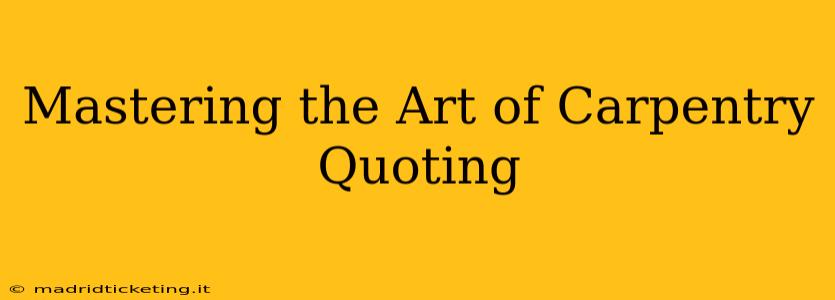Accurate and competitive carpentry quoting is crucial for success in the industry. It’s more than just adding up materials and labor; it's a delicate balance of understanding your costs, pricing strategically, and building trust with clients. This guide will equip you with the skills to master this art, ensuring profitability and client satisfaction.
What Factors Go Into a Carpentry Quote?
This is the foundational question. A comprehensive carpentry quote considers far more than just the lumber. Several key factors must be included for an accurate estimate:
- Materials: This is the most obvious component. Detail each material needed – type of wood, fasteners, adhesives, finishes, etc. Obtain current pricing from your suppliers, accounting for potential price fluctuations. Don't forget to include waste factor – lumber often needs extra to account for cuts and imperfections.
- Labor: This is where expertise truly shines. Accurately estimating labor hours requires experience. Break down the project into smaller tasks (e.g., framing, sheathing, finishing) and assign realistic timeframes for each. Consider your hourly rate and any necessary employee wages.
- Overhead: This often-overlooked aspect includes business expenses like insurance, vehicle maintenance, tools, and office supplies. Accurately factoring overhead ensures profitability beyond just material and labor costs.
- Profit Margin: This is your reward for expertise and risk. A healthy profit margin ensures long-term sustainability. Research industry standards and determine a margin that aligns with your business goals and market competition.
- Permits and Inspections: Some projects require permits and inspections. Include these costs, researching local regulations to avoid unexpected expenses.
- Contingency: Unexpected issues are part of construction. A contingency buffer (typically 5-10%) accounts for unforeseen problems, preventing cost overruns and protecting your profit.
How Do I Calculate Labor Costs Accurately?
Accurately calculating labor costs is arguably the most challenging aspect. Here's a breakdown:
- Detailed Task Breakdown: Thoroughly analyze the project, breaking it down into individual tasks. This provides a clearer picture of the time commitment for each.
- Time Tracking: Track your time meticulously on similar past projects. This historical data provides a valuable benchmark for future estimates.
- Experience Level: Account for the skill level required for each task. More complex work requires more experienced (and higher-paid) carpenters.
- Efficiency: Factor in realistic efficiency rates. Unexpected delays are inevitable, so a slightly higher time estimate is often prudent.
What is a Reasonable Profit Margin for Carpentry?
The ideal profit margin depends on several variables: your overhead, market competition, and project complexity. However, a range of 15-25% is generally considered reasonable within the carpentry industry. This allows for covering expenses, reinvestment, and ensuring a sustainable business.
How to Price Your Carpentry Services Competitively?
Pricing competitively requires a delicate balance:
- Market Research: Research competitor pricing in your area. Understanding the local market helps ensure your quotes are in line with industry standards.
- Value Proposition: Highlight the value you bring – expertise, quality materials, prompt service, and guarantees. This justifies a higher price point for superior service.
- Negotiation: Be prepared to negotiate, but know your bottom line. Avoid undercutting yourself to the point of unprofitability.
How Can I Create Professional-Looking Carpentry Quotes?
Presentation matters. A professional quote reflects your professionalism and builds client confidence. Utilize:
- Pre-designed Templates: Many software options and templates are available online.
- Clear and Concise Language: Avoid jargon. Use clear, easy-to-understand language.
- Itemized Breakdown: Detail every cost component (materials, labor, overhead, profit margin, etc.).
- Payment Terms: Clearly outline payment schedules and accepted methods.
- Contact Information: Include your contact details prominently.
Mastering the art of carpentry quoting is an ongoing process. Consistent practice, meticulous record-keeping, and a commitment to continuous learning will refine your skills, leading to greater success in your carpentry business.

